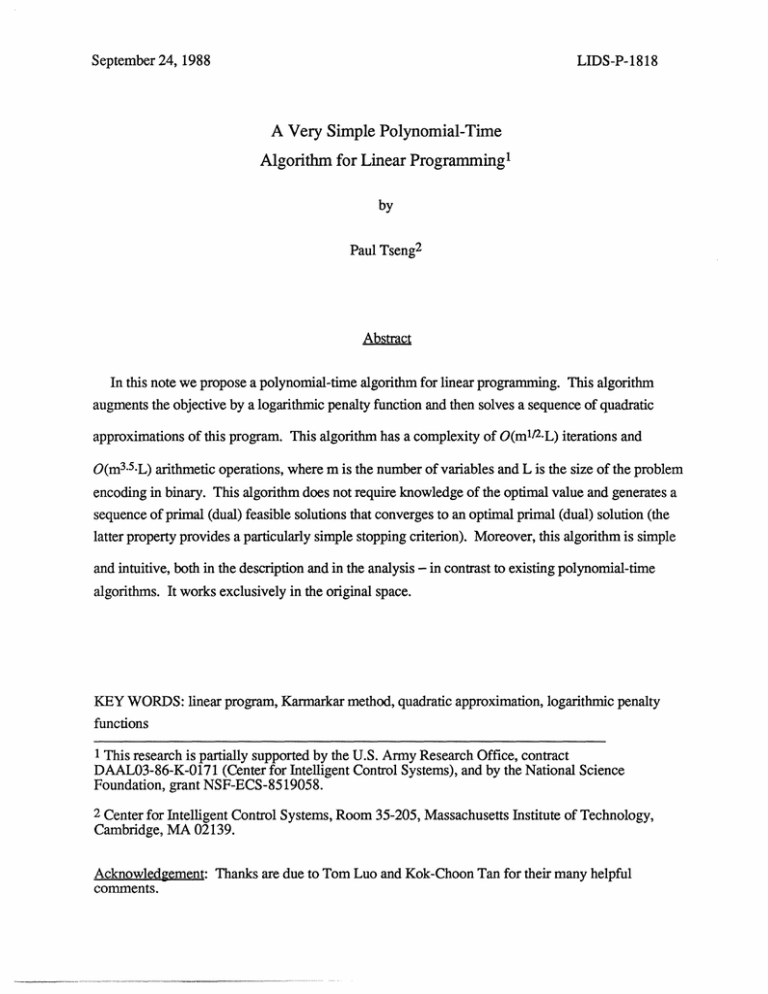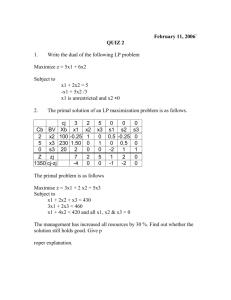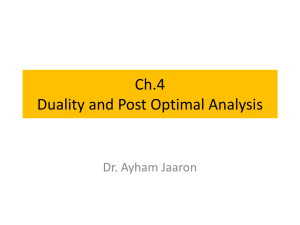A Very Simple Polynomial-Time Algorithm for Linear Programming
advertisement

LIDS-P-1818
September 24, 1988
A Very Simple Polynomial-Time
Algorithm for Linear Programming1
by
Paul Tseng 2
Abstract
In this note we propose a polynomial-time algorithm for linear programming. This algorithm
augments the objective by a logarithmic penalty function and then solves a sequence of quadratic
approximations of this program. This algorithm has a complexity of O(ml/2 -L) iterations and
O(m 3 .5 .L) arithmetic operations, where m is the number of variables and L is the size of the problem
encoding in binary. This algorithm does not require knowledge of the optimal value and generates a
sequence of primal (dual) feasible solutions that converges to an optimal primal (dual) solution (the
latter property provides a particularly simple stopping criterion). Moreover, this algorithm is simple
and intuitive, both in the description and in the analysis - in contrast to existing polynomial-time
algorithms. It works exclusively in the original space.
KEY WORDS: linear program, Karmarkar method, quadratic approximation, logarithmic penalty
functions
1 This research is partially supported by the U.S. Army Research Office, contract
DAAL03-86-K-0171 (Center for Intelligent Control Systems), and by the National Science
Foundation, grant NSF-ECS-8519058.
2 Center for Intelligent Control Systems, Room 35-205, Massachusetts Institute of Technology,
Cambridge, MA 02139.
Acknowledgement: Thanks are due to Tom Luo and Kok-Choon Tan for their many helpful
comments.
1. Introduction
Consider linear programming problems of the form
Minimize
(c,x)
subject to
Ax = b, x > 0,
(P)
where c is an m-vector, A is an nxm matrix, b is an n-vector, and (.,.) denotes the usual Euclidean
inner product. In our notation, all vectors are column vectors and superscript T denotes the
transpose. We will denote by 93m (9n) the m-dimensional (n-dimensional) Euclidean space.
For any vector x in 9tm, we will denote by xj the jth component of x. For any positive vector x
in
91m,
we will denote by D x the mxm positive diagonal matrix whose jth diagonal entry is the jth
component of x. Let X denote the relative interior of the feasible set for (P), i.e.
X= { xe9imlAx=b, x>O }.
We will also denote by e the vector in 9 1m all of whose components are l's. "Log" will denote the
natural log and 11-111, 11-112 will denote, respectively the L 1-norm and the L 2 -norm. We make the
following standing assumption about (P):
Assumption A:
(a)
Both X and { uE 9t n I ATu < c } are nonempty.
(b)
A has full row rank.
Assumption A (b) is made only to simplify the analysis and can be removed without affecting either
the algorithm or the convergence results. Note that Assumption A (a) implies (cf. [3], Corollary
29.1.5) that the set of optimal solutions for (P) is nonempty and bounded. For any e > 0, consider
the following approximation of (P):
Minimize
f,(x)
subject to
Ax = b,
(Pd)
2
where we define f,:(0,oo)m--*9 to be the penalized function:
(1.1)
fe(x) = (c,x) - £CX log(xj).
Note that
-l/xl-
l/(X@)2
V2 f8 (x) =
Vfe(x) = c-E ,
l/xm
...
m
:
.
(1.2)
1/(Xm)2
O
The literature on Karmarkar's algorithm [1] is too vast to survey and we will not do so here. Our
approach to solving (P), which is similar to that taken in [5]-[6], [11], is to solve, approximately, a
sequence of problems {(Per) }, where {er} is a sequence of geometrically decreasing scalars. The
approximate solution of (Per), denoted by xr, is obtained by solving the quadratic approximation of
(Per) around x r-l. The novel feature of our algorithm is its simplicity, both in the description and in
the analysis. And yet it has an excellent complexity. Also, our algorithm is unusual in that it is a
primal affine-scaling algorithm that generates feasible primal and dual solutions.
This note proceeds as follows: in §2 we show that, given an approximately-optimal primal dual
pair of (P.), an approximately-optimal primal dual pair of (Pa), for some aE (0,1), can be obtained
by solving a quadratic approximation of (P.). In §3 and §4 we present our algorithm and analyze its
convergence. In §5 we discuss the initialization of our algorithm. Finally, in §6 we give our
conclusion and discuss extensions.
2. Technical Preliminaries
Fix any e > 0 and consider the problem (P.)
Minimize
(c,x) - Ej
subject to
Ax = b,
log(xj)
3
and let x be any element of X and let u be any element of 91n. We replace the objective function by
its quadratic approximation around x = x. This gives (cf. (1.2))
Minimize
(c-E(D)-le,z) + £(z,D)-2z)/2
subject to
Az = 0,
where we denote D = Dox. The Karush-Kuhn-Tucker point for this problem, say (z,u), satisfies
c - (D)-le + e()- 2 z - ATu = 0,
(2.1a)
Az = 0.
(2. 1b)
Let d = (D)-lz. Solving for d gives
Ed = [I - (AD)T(AD 2AT)-lAD]r,
(2.2)
where we denote
r = -Dc + £e + (AD)T'u.
Note that, since the orthogonal projection is a nonexpansive mapping (with respect to the L 2 -norm),
we have from (2.2)
IIdll2 •< I[ll 2/e.
(2.3)
x = x+z,
(2.4)
Let
D = D x , and A = Dd. Then D = D+ AD and hence
-Dc + Ee + (AD)Tu = [-Dc + Ee + (AD)Tu] + A[-Dc + (AD)Tu]
= Ed + A[-Dc + (AD)Tu]
= A[ee -Dc + (AD)Tu]
4
= EAd,
where the second and the fourth equality follow from (2.la). This implies that (with dj denoting the
jth component of d)
II-Dc + ee + (AD)Tull 2 = ellAdll 2
< ellAdll 1
= £j
=
(dj) 2
£(11d112)2
2
< (Fr 11
2 ) /E,
(2.5)
where the first inequality follows from properties of the L 1 -norm and the L 2 -norm and the second
inequality follows from (2.3).
Consider any
fr (0,1) and any scalar a
satisfying
(p2+ml/2 )/(t-ml/2 ) < a < 1.
(2.6)
Let £' = at and r' = -Dc + £'e + (AD)Tu. Then
lIr'112 /e' = 11-Dc + ace + (AD)TulII2 /(a)
< II-Dc + ce + (AD)Tull2 /(ac)
< (1l11
/e)
2
2/a
+ (1-a)-ml/2/a
+ (1/a-1).ml/ 2 ,
where the first inequality follows from the triangle inequality and the second inequality follows from
(2.5). Hence, by (2.6), if [ill2/£ < [, then IIr'1l2/£' < [. Furthermore, by (2.3), we have that 11dll 2 <
[ < 1. Hence e+d > 0 and (cf. (2.4)) x > O0.Also, by (2. lb) and (2.4), Ax = A(x+z) = b.
For any £ > 0, let p,:(0,oo)mx91n->[0,oo) denote the function
5
(2.7)
p,(y,p) = II-Dyc + -e + (ADy)Tpll2 /E.
We have then just proved the following important lemma:
Lemma 1
For any £ > 0, any OEr (0,1) and any (x,u)e XxS9n such that pe(x,u) < 5, we have
(x,u)EXx9 n,
pCas(x,u) < 1,
where a = (02+ml/ 2 )/([Brml/2) and (x,u) is defined as in (2. la), (2. lb), (2.4).
3. The Homotopy Algorithm
Choose a = (1/4+m 1/ 2 )/(1/2+m 1/ 2 ). Lemma 1 and (2.1a)-(2.lb), (2.4) motivate the following
variant of Karmarkar's algorithm, parameterized by two positive scalars y < £:
Homotopy Algorithm
Step 0:
Choose any (xl,ul)e Xx91 n such that p,(xl,ul) < 1/2. Let e 1 = £.
Step r:
Compute (zr+l,ur+l) to be a solution of
[r(Dxr)-2
-AT
A
0
1
u
er(D)-le-c
0
Set xr+l = x r + zr+l, £r+l = CEr.
If £r+1 < y, terminate.
[Note: For simplicity we have fixed 1 = 1/2.] We gave the above algorithm the name "homotopy"
because it solves (approximately) a sequence of problems {(Pr)} that approaches (P) (see [2]).
6
4. Convergence Analysis
By Lemma 1, the homotopy algorithm generates, in at most (log(y)-log(e))/log(a) steps, an
(x,u)E Xx91n satisfying
Il-Dxc + ,e + (ADx)Tull 2 < 3/2,
(4.1)
Ax = b.
Since y > 0, (4.1) implies that
o
< Dxc - (ADx)Tu < (3y/2).e.
Since D x is a positive diagonal matrix, multiplying both sides by (DX)-1 gives
O < c - ATu < (3Y/2)-(Dx)-le.
This in turn implies that, for each jE {1,...,m},
o
< c - (Aj,u) < 3y1/2/2
if xj >2 1/2,
o
< cj - (Aj,u)
otherwise,
where cj denotes the jth component of c and Aj denotes the jth column of A (note that an analogous
argument shows that ur is dual feasible for all r). Also, since
log(l-6) = -6 - 52/2 - 53/3 - 64/4 -...
< -6(1 + (6/2) + (6/2)2 + (6/2)3 + ... )
= -6/(1-6/2) = -1/(1/6-1/2),
for any &E (0,1), we have that
log(a) = log(l-(2+4ml/ 2)-1 )
7
< -1/(2+4ml/ 2 -1/2).
Hence we have just proved following:
Lemma 2
For any positive scalars y < e, the homotopy algorithm generates, in at most
(3/2+4ml/2 ).(log(e)-log(y)) steps, a pair of optimal primal and dual solutions to a perturbed
problem of (P), where the costs are perturbed by at most 3y1/2/2 and the lower bounds are perturbed
by at most y1/2.
Thus if we choose e = 2e(L) and y = 2-O(L), where L denotes the size of the problem encoding in
binary (defined as in [1]), the homotopy algorithm would terminate in O(ml/2-L) steps with an
optimal primal dual solution pair to a perturbed problem of (P) and the size of the perturbation is
2-0(L). An optimal primal dual solution pair to (P) can then be recovered by using, say, the
techniques described in [7] (also see [1]). Since the amount of computation per step is at most
O(m 3 ) arithmetic operations (not counting Step 0), the homotopy algorithm has a complexity of
O(m 3. 5 -L) arithmetic operations. [We assume for the moment that Step 0 can be done very "fast".
See §5 for justification.] This complexity can be reduced to O(m- 3 31L) by using Strassen's
(impractical) matrix inversion method [10]. It may be possible to reduce the complexity to O(m3 L)
by using the rank-one update technique described in [1], [11].
5. Algorithm Initialization
In this section we show that, for e sufficiently large, Step 0 of the homotopy algorithm (i.e. to
generate a primal dual pair (x,u)e Xx9Rn satisfying p,(x,u) < 1/2) can be done very "fast".
Suppose that (P) is in the canonical form considered by Karmarkar (see §5 of [1] for details on
how to transform general linear programs into this canonical form). We claim that, for e = 211c112, a
point (x,u)e Xx9in satisfying p,(x,u) < 1/2 can be found immediately. To see this, note that in
Karmarkar's canonical form, A and b have the form
A
,'
=
b==,1
where A' is some (n-1)xm matrix, and the point e is assumed to satisfy Ae = b. Let x = e and p =
(0,...,O,-1)T. Then
e + (ADx)Tp = e + ATp
=e-e = 0.
(5.1)
Hence, by (2.7), x = e, and the triangle inequality,
p,(x,£p) = II-DXC + ee + E(ADx)Tpll2 /e
< IIcll 2/Le + lie + (ADx)Tp112
= 1/2.
Alternatively, we can solve the following problem
Maximize
,jlog(xj)
(5.2)
subject to Ax = b,
whose Karush-Kuhn-Tucker point (x,p) can be seen to satisfy (5.1) (such a point exists if the
feasible set for (P) is bounded). Then, for e = 211DXCII 2 , we also have p,(x,ep) < 1/2. The (unique)
primal solution of (5.2) is sometimes called the analytic center [8] of the convex polyhedron { x I Ax
= b, x > 0 }. Polynomial-time algorithms for solving (5.2) are described in [8] and [9] (note that
(5.2) does not have to be solved exactly).
6. Conclusion and Extensions
In this note we have proposed a very simple polynomial-time algorithm for linear programming.
This algorithm solves a sequence of approximations to the original problem, each augmented by a
9
logarithmic penalty function, and, unlike many other Karmarkar-type algorithms, uses no space
transformation of any kind. This algorithm uses a number of steps (namely O(ml/2L)) that is the
lowest amongst interior point methods for linear programming. Because the primal and dual
solutions obtained at each step are respectively primal and dual feasible, determining termination is
particularly simple: terminate if the difference in their costs is below a prespecified tolerance.
There are many directions in which our result can be extended. Can the complexity be decreased
further? Can our algorithm extend to quadratic programming or to problems with upper bound on
the variables? Does there exist a general class of convex functions he:X--X, where X is a convex
set in 9 tm, such that h,(x) -- ho(x) pointwise as £ 1 0 and, given an approximate minimum of he, an
approximate minimum of ha (a is a sufficiently small scalar in (0,1)) can be obtained very
"quickly"?
10
References
[1]
Karmarkar, N., "A New Polynomial-Time Algorithm for Linear Programming,"
Combinatorica, 4 (1984), 373-395.
[2]
Garcia, C. B. and Zangwill, W. I., Pathways to Solutions, Fixed Points, and Equilibria,
Prentice-Hall, Inc., N. J. (1981).
[3]
Rockafellar, R. T., Convex Analysis, Princeton University Press, Princeton, N.J. (1970).
[4]
Bertsekas, D. P., ConstrainedOptimization and LagrangeMultiplierMethods, Academic Press
(1982).
[5]
Gonzaga, C. C., "An Algorithm for Solving Linear Programming Problems in O(n 3 L)
Operations," Memo. UCB/ERL M87/10, Electronics Research Laboratory, University of
California, Berkeley, CA (March 1987).
[6]
Monteiro, R. C., and Adler, I., "An O(n 3 L) Primal-Dual Interior Point Algorithm for Linear
Programming," Technical Report, Department of Industrial Engineering and Operations
Research, University of California, Berkeley, CA (May 1987).
[7]
Gr6tschel, Lovdsz, and Schrijver, A., "The Ellipsoid Method and its Consequences in
Combinatorial Optimization," Combinatorica, 1 (1981), 169-197.
[8]
Sonnevend, G., "An 'Analytical Center' for Polyhedrons and New Classes of Global
algorithms for Linear (Smooth, Convex) Programming," Preprint, Dept. of Numerical
Analysis, Institute of Mathematics Eotvos University, 1088, Budapest, Muzeum Korut, 6-8
(1985).
[9]
Freund, R. M., "Projective Transformations for Interior Point Methods, Part II: Analysis of an
Algorithm for finding the Weighted Center of a Polyhedral System," OR 180-88, Operations
Research Center, M.I.T., MA (June 1988).
[10] Strassen, V., "Gaussian Elimination is not Optimal," Numerische Mathematik, 13 (1969),
354-356.
[11] Gonzaga, C. C., "An Algorithm for Solving Linear Programming in O(n3 L) Operations,"
Technical Report UCB/ERL M87/10, Electronics Research Laboratory, University of
California, Berkeley, CA (March 1987).
11
[12] Gill, P. E., Murray, W., Saunders, M. A., Tomlin, J. A., and Wright, M. H., "On Projected
Newton Methods for Linear Programming and Equivalence to Karmarkar's Projective
Method," MathematicalProgramming,36 (1986), 183-209.








